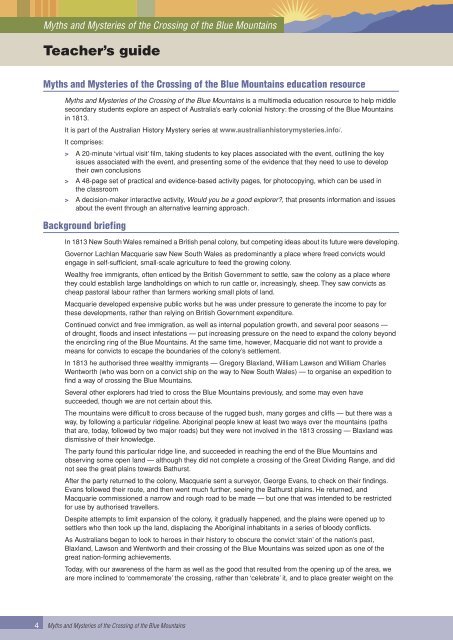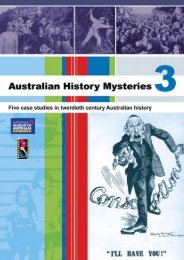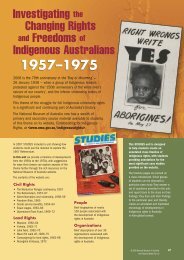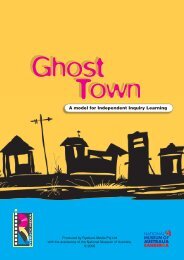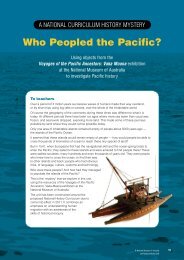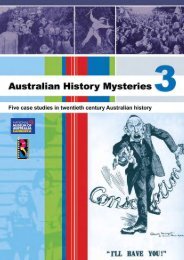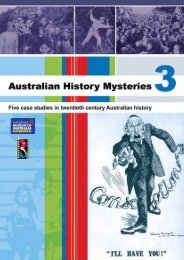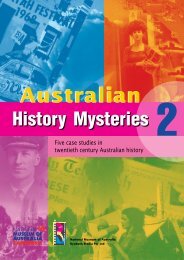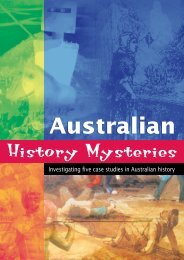Download Teacher Guide & Print Resources - Australian History ...
Download Teacher Guide & Print Resources - Australian History ...
Download Teacher Guide & Print Resources - Australian History ...
Create successful ePaper yourself
Turn your PDF publications into a flip-book with our unique Google optimized e-Paper software.
Myths and Mysteries of the Crossing of the Blue Mountains<br />
<strong>Teacher</strong>’s guide<br />
Myths and Mysteries of the Crossing of the Blue Mountains education resource<br />
Myths and Mysteries of the Crossing of the Blue Mountains is a multimedia education resource to help middle<br />
secondary students explore an aspect of Australia’s early colonial history: the crossing of the Blue Mountains<br />
in 1813.<br />
It is part of the <strong>Australian</strong> <strong>History</strong> Mystery series at www.australianhistorymysteries.info/.<br />
It comprises:<br />
> A 20-minute ‘virtual visit’ film, taking students to key places associated with the event, outlining the key<br />
issues associated with the event, and presenting some of the evidence that they need to use to develop<br />
their own conclusions<br />
> A 48-page set of practical and evidence-based activity pages, for photocopying, which can be used in<br />
the classroom<br />
> A decision-maker interactive activity, Would you be a good explorer?, that presents information and issues<br />
about the event through an alternative learning approach.<br />
Background briefing<br />
In 1813 New South Wales remained a British penal colony, but competing ideas about its future were developing.<br />
Governor Lachlan Macquarie saw New South Wales as predominantly a place where freed convicts would<br />
engage in self-sufficient, small-scale agriculture to feed the growing colony.<br />
Wealthy free immigrants, often enticed by the British Government to settle, saw the colony as a place where<br />
they could establish large landholdings on which to run cattle or, increasingly, sheep. They saw convicts as<br />
cheap pastoral labour rather than farmers working small plots of land.<br />
Macquarie developed expensive public works but he was under pressure to generate the income to pay for<br />
these developments, rather than relying on British Government expenditure.<br />
Continued convict and free immigration, as well as internal population growth, and several poor seasons —<br />
of drought, floods and insect infestations — put increasing pressure on the need to expand the colony beyond<br />
the encircling ring of the Blue Mountains. At the same time, however, Macquarie did not want to provide a<br />
means for convicts to escape the boundaries of the colony’s settlement.<br />
In 1813 he authorised three wealthy immigrants — Gregory Blaxland, William Lawson and William Charles<br />
Wentworth (who was born on a convict ship on the way to New South Wales) — to organise an expedition to<br />
find a way of crossing the Blue Mountains.<br />
Several other explorers had tried to cross the Blue Mountains previously, and some may even have<br />
succeeded, though we are not certain about this.<br />
The mountains were difficult to cross because of the rugged bush, many gorges and cliffs — but there was a<br />
way, by following a particular ridgeline. Aboriginal people knew at least two ways over the mountains (paths<br />
that are, today, followed by two major roads) but they were not involved in the 1813 crossing — Blaxland was<br />
dismissive of their knowledge.<br />
The party found this particular ridge line, and succeeded in reaching the end of the Blue Mountains and<br />
observing some open land — although they did not complete a crossing of the Great Dividing Range, and did<br />
not see the great plains towards Bathurst.<br />
After the party returned to the colony, Macquarie sent a surveyor, George Evans, to check on their findings.<br />
Evans followed their route, and then went much further, seeing the Bathurst plains. He returned, and<br />
Macquarie commissioned a narrow and rough road to be made — but one that was intended to be restricted<br />
for use by authorised travellers.<br />
Despite attempts to limit expansion of the colony, it gradually happened, and the plains were opened up to<br />
settlers who then took up the land, displacing the Aboriginal inhabitants in a series of bloody conflicts.<br />
As <strong>Australian</strong>s began to look to heroes in their history to obscure the convict ‘stain’ of the nation’s past,<br />
Blaxland, Lawson and Wentworth and their crossing of the Blue Mountains was seized upon as one of the<br />
great nation-forming achievements.<br />
Today, with our awareness of the harm as well as the good that resulted from the opening up of the area, we<br />
are more inclined to ‘commemorate’ the crossing, rather than ‘celebrate’ it, and to place greater weight on the<br />
4<br />
Myths and Mysteries of the Crossing of the Blue Mountains


